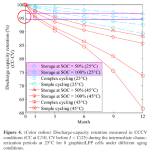Experts,
I built a 20S Wina50AH (LiFePO4)pack for my scooter Electra2500W.
Recharging the pack with a simple 20S charger just doesn't work because I have the first weakest cell that goes way above the maximum voltage of 3.6V and other cells remain below.
So I built this home made charge balancer based on TLV431 following this design:
http://m.electronicdesign.com/analog/high-current-low-voltage-shunt-regulator
Basically it is 20x shunt regulators tuned at 3.6V in parallel with every cells; this way when a cell reaches 3.6V the shunt drains all charging current from that cell which remains at 3.6V while other cells keep charging.
It seems to work pretty well, but I have the following question?
I do this balancing phase at pretty low current, between 200 and 400 mA, so it can take several hours; this means that some cells can stay at 3.6V for such long time. Can this produce overcharging or in any way damage the cell?
Thanks,
Luca.

I built a 20S Wina50AH (LiFePO4)pack for my scooter Electra2500W.
Recharging the pack with a simple 20S charger just doesn't work because I have the first weakest cell that goes way above the maximum voltage of 3.6V and other cells remain below.
So I built this home made charge balancer based on TLV431 following this design:
http://m.electronicdesign.com/analog/high-current-low-voltage-shunt-regulator
Basically it is 20x shunt regulators tuned at 3.6V in parallel with every cells; this way when a cell reaches 3.6V the shunt drains all charging current from that cell which remains at 3.6V while other cells keep charging.
It seems to work pretty well, but I have the following question?
I do this balancing phase at pretty low current, between 200 and 400 mA, so it can take several hours; this means that some cells can stay at 3.6V for such long time. Can this produce overcharging or in any way damage the cell?
Thanks,
Luca.



